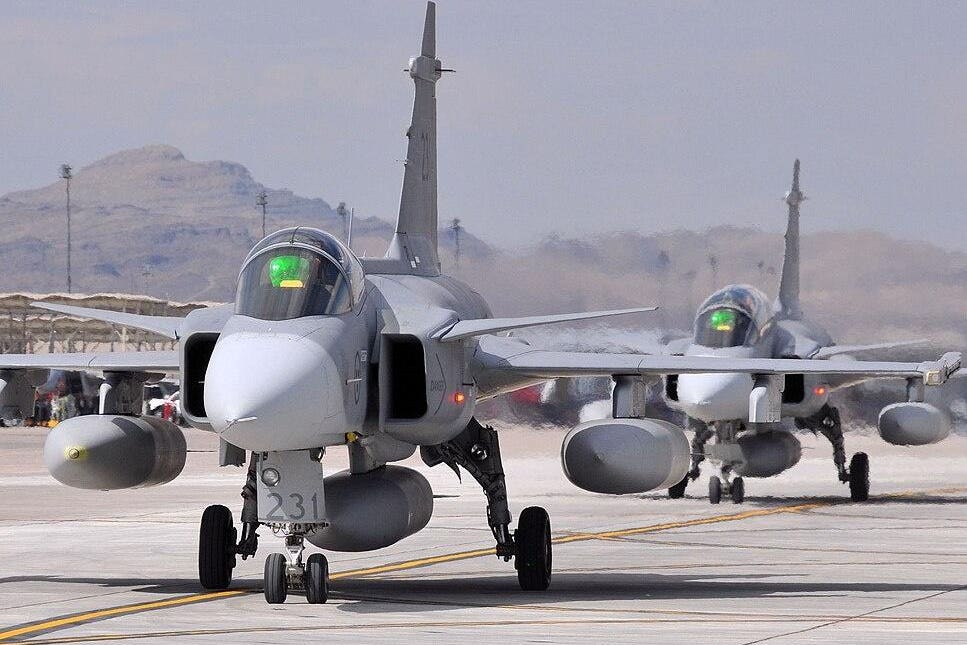Months of determined diplomacy by Ukrainian officials finally paid off in recent weeks as three NATO countries—Denmark, The Netherlands and Norway—agreed to donate to Ukraine enough surplus Lockheed Martin F-16 fighters to equip several squadrons.
But Kyiv isn’t done asking. Ukraine would need more than 50 or 60 F-16s fully to reequip its air force with its 125 or so aging Soviet-made jets. To help to make up the balance, Ukrainian president Volodymyr Zelensky went to Sweden last week and made the case for Stockholm to give away some of its Saab JAS 39 Gripen fighters.
The Swedish air force has around a hundred early-model JAS-39C/Ds and is replacing them with at least 60 new JAS-39Es.
It’s obvious why the Ukrainians would want Gripens. Even more than the F-16, the Gripen seems to be tailor-made for the kind of war Ukraine is fighting. Perhaps most importantly, the Swedish jet has no problem operating from roads.
Roadway ops mitigate one of the big weaknesses of modern warplanes: their air bases. There’s no way to hide a 5,000-acre air base with a 10,000-foot runway. In any major war between high-tech foes sharing a border, both sides can expect the other to target its air bases.
One solution is the most obvious: abandon the air bases in favor of roads and highways that, in a pinch, can function as airstrips. The Soviet air force, now the Russian air force, specifically designed its warplanes for this kind of dispersal.
Look closely at a Mikoyan MiG-29 fighter while it’s landing. As it touches down on its reinforced landing gear, doors close over its gaping air-intakes while gates open on top of the intakes. This system prevents rocks and other “foreign object debris,” or FOD, from wrecking the jet’s engines while it’s operating from a dirty roadway.
Similar anti-FOD systems are standard on the Soviet-style jets that equip Ukraine’s air force: not just MiG-29s, but also Sukhoi Su-24 bombers, Sukhoi Su-25 attack jets and Sukhoi Su-27 interceptors. The planes’ robustness and short runway requirements—a MiG-29 needs just a thousand feet or so—is why they’ve survived in Ukrainian service.
On the first night of Russia’s wider war on Ukraine on Feb. 24, 2022, the Ukrainian air force—tipped off by NATO intelligence—scattered its jets to outlying airstrips and roadways, saving them from the missile barrages that initiated the Russian invasion.
Eighteen months later, the Ukrainian air force has turned roadway ops into a kind of art. Every time the Russians lob missiles at a Ukrainian air base, the Ukrainians simply vacate the base before the missiles arrive.
Road ops could become more difficult once the F-16s begin arriving in Ukraine in the coming months. While the Taiwanese air force regularly practices landing and launching its F-16s on highways, it typically does so on the same five highways, which the air force carefully maintains specifically for delicate American-made planes.
To operate at full weight, an F-16 needs 2,500 feet of clean runway. And it has no anti-FOD system. Indeed, its gaping under-fuselage intake practically gobbles debris.
The Gripen, by contrast, is a tough, spritely little plane—making it better for dispersed roadway ops than an F-16 is. It doesn’t have the anti-FOD doors that a MiG does, but it does boast tough, tall landing gear. And thanks to its thrust-reverser and canards, which double as brakes, it can operate from 1,500 feet of clean surface.
With Gripens, the Ukrainians could keep right on dodging Russian attacks—by dispersing their planes to short airstrips or stretches of highway. With F-16s, they might have fewer options.
Regardless, the F-16s are coming first. Ex-Danish F-16s should begin arriving by the end of the year. Zelensky meanwhile still is working out, with his Swedish counterparts, the details of a possible Gripen deal. “Ukrainian pilots are already taking part in testing Gripen fighter aircraft,” he stated on Aug. 19. “We discussed further steps to transfer them to Ukraine.”
Read the full article here





